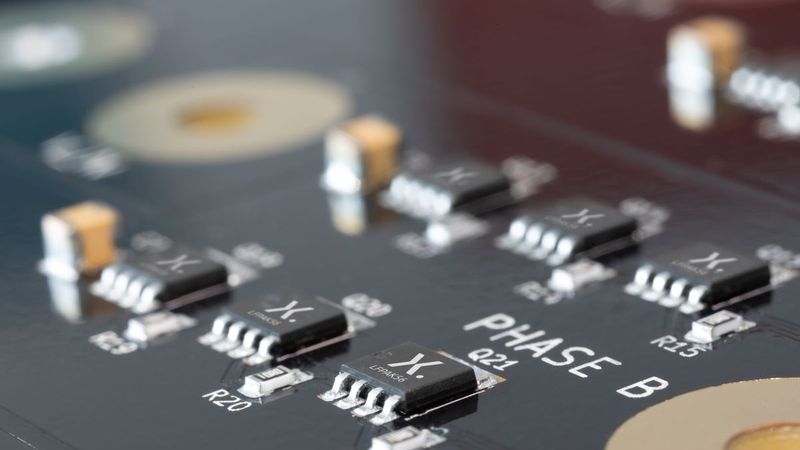2023 Autonomous Vehicle Report Interview: Exploring the Future of High-Performance Computing in Autonomous Vehicles
Sponsor interview with members of the Nexperia Engineering Team about the increasing demands of Advanced Driver-Assistance Systems (ADAS) in autonomous vehicles.
In this interview, Nexperia Engineering staff discuss the challenges and solutions ahead for autonomous vehicles. Download the full report to read all our sponsor interviews.

The automotive industry is grappling with the need to develop hardware that is not only reliable and efficient but also compact enough to fit within the confines of a vehicle. This challenge is amplified by the increasing demands of Advanced Driver-Assistance Systems (ADAS) in autonomous vehicles, which require immense computational resources to process data from an array of sensors and cameras in real-time.
The shift towards centralized ADAS architectures marks a significant departure from traditional vehicle design. These systems resemble mid-range server architectures, equipped with dedicated GPUs optimized for complex algorithms and self-learning capabilities. The processing power required for these systems is immense, necessitating the use of multiple high-power microchips. This evolution raises critical questions about the reliability, safety, and energy consumption of these computing units, especially given their crucial role in autonomous driving.
An intriguing aspect of this technological evolution is the continued relevance of discrete components in automotive systems. Despite advancements in integrated circuits, discrete components like transistors, MOSFETs, and diodes remain vital due to their flexibility, reliability, and cost-effectiveness. This persistence underscores the dynamic nature of automotive semiconductor technology and its critical role in shaping the future of autonomous vehicles.
In this brief interview below we heard from Nexperia engineers as they discuss how the increasing demand for computational power in vehicles is reshaping automotive design, the challenges in ensuring system safety and reliability, and the broader impact of these changes on the semiconductor industry.
What are the most recent trends in terms of incorporating new electronic devices into the vehicle and manufacturing processes?
The automotive industry is undergoing a major transformation, with electronics playing an increasingly important role. Recent trends include electrification, connectivity, and autonomous driving. As the automotive industry shifts towards electric and hybrid vehicles, there is a growing demand for high power and wide-bandgap electronics solutions such as Silicon, SiC and GaN MOSFETs, IGBTs, diodes, and other semiconductor devices capable of efficiently managing and controlling electric power. Nexperia is at the forefront of this trend, developing innovative semiconductor solutions specifically tailored for electric vehicle applications, enabling higher efficiency, increased power density, and improved thermal management in automotive electronics.
How are vectors such as electrification, connectivity and autonomous vehicle developments influencing the role of electronics in automotive?
Electrification, connectivity, and autonomous vehicle developments greatly influence the role of electronics in automotive applications. Electrified vehicles demand more semiconductor content, driving the need for advanced components. Connectivity requires seamless vehicle-infrastructure communication, while autonomous vehicles rely on complex sensor systems. All three vectors are interconnected, with electrified vehicles offering better options for advanced electronics. Components like camera systems, radar systems, and larger displays rely on electronics. Overall, these vectors amplify the role of electronics in the automotive industry, necessitating advancements in electronic components and systems to support powertrain control, communication capabilities, and autonomous functionalities.
How can electronics contribute to areas such as sustainability and efficient energy management?
Electronics play a vital role in enabling sustainability and efficient energy management. At Nexperia, our focus on developing better power semiconductors enables more efficient cars and applications. By minimizing power losses and enhancing power conversion efficiency, our semiconductors significantly contribute to lower energy consumption, reduced carbon emissions, and extended range in electric vehicles. Efficient power electronics also support renewable energy systems, smart grids, and energy-efficient industrial applications. Through our semiconductor solutions, we strive to enable greener technologies, enhance energy efficiency, and drive the transition towards a more sustainable future.
How is your company working on innovating new electronic solutions, either for the vehicle or for your manufacturing processes?
Every new car today already has approximately 600 Nexperia devices, and while our products are very small, the combined effort can have an impact on the efficiency and performance. Thus, we are working on innovating new electronic solutions for both vehicles and manufacturing processes. And while we continuously innovate the “workhorse” silicon, we are also developing leading-edge wide bandgap devices. These silicon carbide (SiC) and gallium nitride (GaN) semiconductors offer higher efficiency and performance compared to traditional silicon-based devices.
By incorporating wide bandgap devices, we enhance power efficiency and improve system performance, reduce size and weight of systems, extend the range of electric vehicles and reduce carbon emissions. We also prioritize the development of more efficient power semiconductors that minimize power losses and improve thermal performance. This ensures reliable and long-lasting electronic systems in vehicles, supporting their overall efficiency and reliability. Our compact and space-efficient package designs optimize PCB space, benefiting car manufacturing processes. By utilizing better-performing power semiconductors, we contribute to increased mileage for car batteries, promoting sustainable transportation. Nexperia remains dedicated to pushing innovation boundaries, focusing on wide bandgap devices, efficient power semiconductors, thermal performance, and space optimization to advance electronic solutions for the automotive industry.
Read more about Nexperia on Wevolver.

